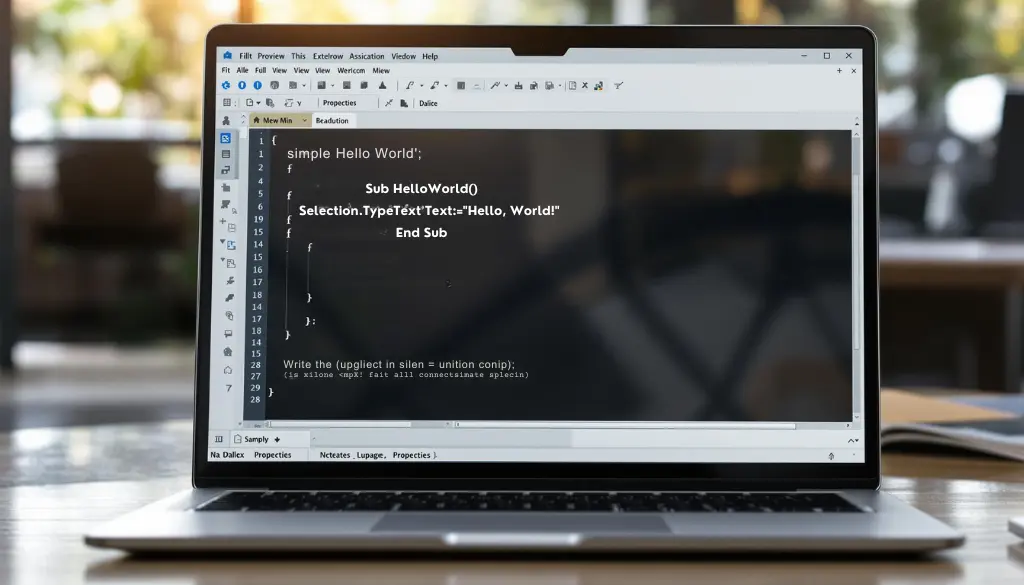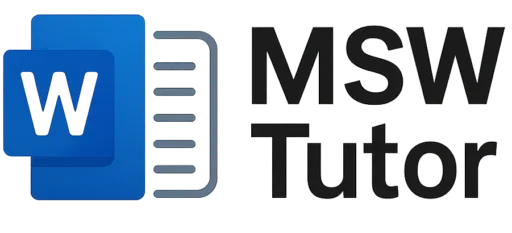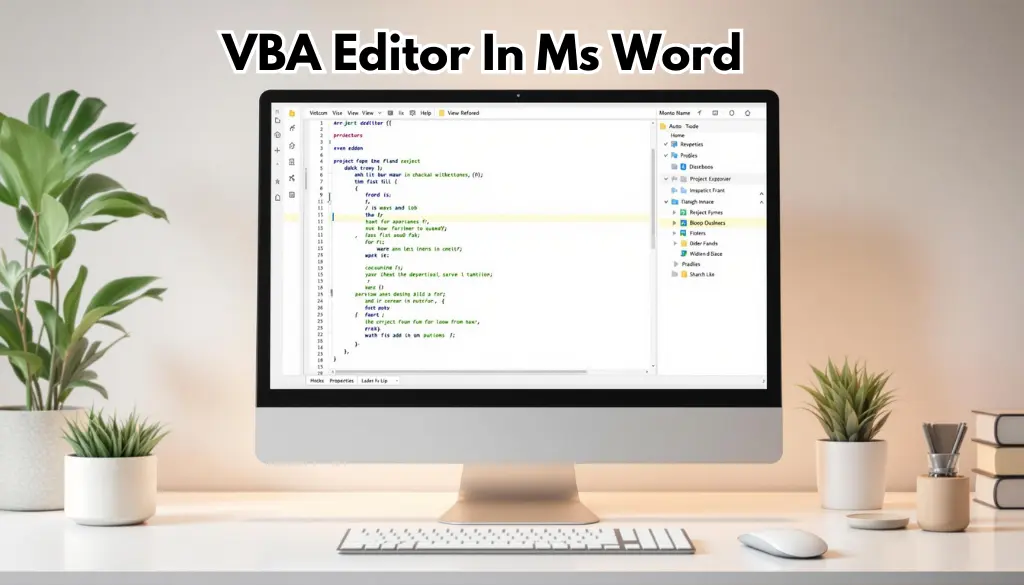Have you ever found yourself doing the same thing in Microsoft Word over and over again, like changing font sizes or applying the same formatting styles? Whether it’s formatting text, copying sections, or other boring tasks, automation can save you time and energy. That’s where VBA (Visual Basic for Applications) comes in, especially with the VBA Editor in MS Word. If you’re new to the VBA Editor or wondering how it can make your work easier, this guide is for you.
In this blog post, we’ll explain what the VBA Editor in MS Word is, why you should use it, and how to get started. We’ll cover everything from the basics to common questions, so by the end, you’ll feel ready to start automating your tasks and make Word work for you.
What Is the VBA Editor in MS Word?

The VBA Editor is a tool that lets you write small programs, called macros, to automate tasks in Microsoft Word. VBA stands for Visual Basic for Applications, a programming language that is built into Microsoft Office. You can use the VBA Editor to create, change, and test macros, giving you more control over how Word works.
The VBA Editor might look a little scary at first. But it’s actually quite easy to use once you get the hang of it. Whether you’re a beginner or someone with some coding experience, learning how to use the VBA Editor can save you a lot of time.
Why Use the VBA Editor in MS Word?

1. Automate Repetitive Tasks
One of the main reasons to use the VBA Editor is to automate repetitive tasks. For example, if you need to format documents in a specific way often, you can create a macro to do it for you with just one click.
2. Save Time and Reduce Errors
With automation, tasks that would usually take hours can be done in seconds. This can help get rid of human errors caused by doing the same thing over and over, making sure your documents are always consistent.
3. Create Custom Commands
The VBA Editor lets you create custom commands that fit your workflow. For example, you could create a macro that changes the font of your document, adds a header, and inserts your company logo – all at once.
4. Boost Productivity
People who automate parts of their work can boost their productivity by up to 30% (Source: Productivity Study). Learning how to use the VBA Editor in MS Word can help you work smarter, not harder. If you’re looking to further customize your documents, our guide on how to use Microsoft Word with Google Docs can be very helpful.
How to Access the VBA Editor in MS Word

To start with VBA, you first need to know how to access the VBA Editor in MS Word. Follow these steps:
- Open MS Word: Start by opening Microsoft Word.
- Go to the Developer Tab: If you don’t see the Developer tab on the ribbon, you need to turn it on. To do this:
- Click on File > Options > Customize Ribbon.
- Check the box next to Developer and click OK.
- Click on the Developer Tab: Once the Developer tab is visible, click on it and then click Visual Basic to open the VBA Editor.
You can also press Alt + F11 to open the VBA Editor directly.
Exploring the VBA Editor: What You Need to Know
The VBA Editor might seem overwhelming at first, but it has a few important parts that are easy to understand. These include the Code Window, Project Explorer, Properties Window, and Immediate Window, which we will cover below.
1. Code Window
The Code Window is where you write the actual VBA code. Each macro has its own code, and this is where the magic happens.
2. Project Explorer
The Project Explorer is like a file manager for all your Word macros. It shows all the open projects, each with different documents and modules. It helps you move between different parts of your macros.
3. Properties Window
The Properties Window lets you change settings for your macros or forms. You can rename modules or change how your macro works.
4. Immediate Window
The Immediate Window is a tool for testing and debugging your code. If something isn’t working, you can use it to test parts of your macro or see what values your variables have.
Writing Your First Macro in the VBA Editor

Step 1: Create a New Macro
- Open the VBA Editor and go to Insert > Module. This will create a new module where you can write your VBA code.
Step 2: Write Your Code
- Let’s start with a simple macro that will type “Hello, World!” in your Word document:
Sub HelloWorld()
Selection.TypeText Text:="Hello, World!"
End SubStep 3: Run the Macro
- Close the VBA Editor by clicking the X in the top-right corner.
- Back in Word, press Alt + F8, select your macro (in this case, “HelloWorld”), and click Run.
This is a basic example, but it’s the first step toward using VBA to automate your work.
Frequently Asked Questions (FAQs) About the VBA Editor in MS Word
1. Is VBA Difficult to Learn?
No, VBA is one of the easiest programming languages to learn for beginners. Many people start learning programming with VBA because it’s easy to see the results in Word, Excel, or other Microsoft Office programs.
2. Can I Undo Changes Made by a Macro?
No, macros don’t have an undo function. So, it’s very important to save your document before running a new macro.
3. Can VBA be Used in Other Office Programs?
Yes! VBA can be used in other Microsoft Office programs like Excel, PowerPoint, and Access, making it a great tool for productivity.
Common VBA Commands to Know
If you want to get good at using the VBA Editor in MS Word, knowing some common commands is a good start. Here are a few:
- Selection.Font.Bold = True: Makes the selected text bold.
- Selection.Font.Size = 14: Changes the font size of the selected text to 14.
- Documents.Add: Creates a new Word document.
- Selection.TypeText: Types the given text at the cursor position.
These commands are the foundation of most macros and are easy to change as you learn more.
Tips for Using the VBA Editor in MS Word Effectively
1. Start Small and Build Up
If you’re new, focus on small tasks that don’t need a lot of code, like creating a macro to format text. As you get more confident, you can take on bigger projects.
2. Test Your Macros Often
Every time you make changes to your macro, test them right away. This way, you can find problems quickly without having to look through a lot of code.
3. Use Comments in Your Code
Adding comments makes your code easier to understand later. Comments start with a single quote (') and are ignored by the VBA Editor.
4. Use Online Resources
There are many tutorials, forums, and guides online to help you learn VBA. Don’t hesitate to use these resources to improve your skills.
Real-Life Examples of VBA in MS Word
Example 1: Formatting a Document
Imagine you get a document that needs to be formatted the same way—like certain fonts, spacing, and headers. With a macro, you could make all these changes at once, saving hours of manual work.
Example 2: Sending Automated Emails
You can also use VBA to send emails through Outlook directly from Word. For example, if you need to send a template email after finishing a report, a macro could do that in seconds.
Conclusion
The VBA Editor in MS Word is a powerful tool that can change how you work. For more in-depth information on fixing layout issues, check out our article on fixing document layout problems. Whether you’re trying to automate boring tasks, reduce mistakes, or create custom workflows, the VBA Editor gives you the power to do it easily. It might seem complicated at first, but with a little practice, VBA can make a big difference in your productivity.
So, why not give it a try today? Start small, experiment, and see how much time you can save. You might also want to explore our guide on how to easily add Visio diagrams in MS Word to enhance your document workflows. For more information, you can also visit the official Microsoft support page on VBA basics. Automation is the key to working efficiently, and with the VBA Editor, you have the tools to unlock that potential.
If you’re ready to learn more, check out our detailed guide on how to change theme effects in MS Word, or you might find our guide on how to create custom theme colors in MS Word helpful as well.

